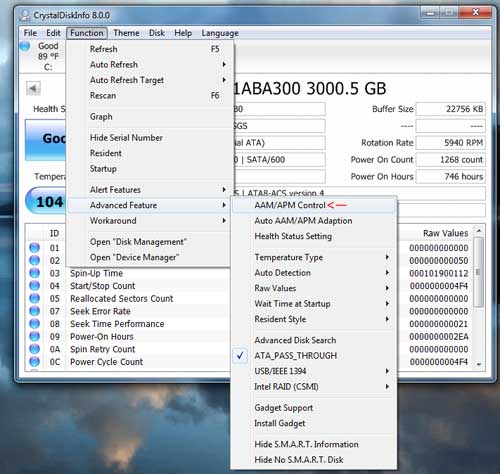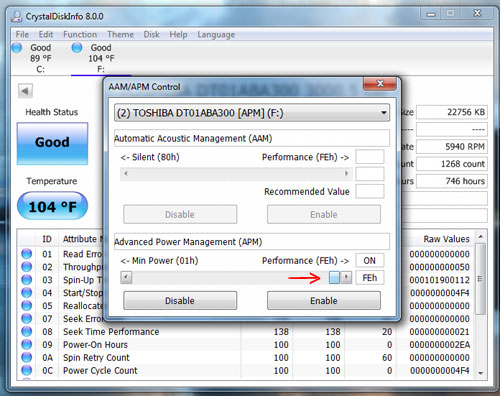Hard Drive ‘Auto SpinDown’: Another Garbage Feature that Cannot Be Disabled
Some time ago, I bought a new Toshiba, 5-terabyte external hard drive for storage purposes. It operates via USB and is plug and play. It has performed very well, except for one thing. After a certain number of minutes of not using it, the drive quits spinning and goes to sleep. Then, if I want to access any files on it after the auto spindown, it wakes up and takes a number of seconds to spin back up to full speed so that my files can be accessed.
This is extremely annoying! Whose bright idea was this? Apparently, another “gift” from techies who think they know better than you what you want or need.
Not only does this auto spindown cause an unnecessary delay, but it also causes additional wear and tear on the drive. The torque that is required to bring a drive up to full speed, from a dead stop, adds a lot of extra wear. It is a lot of extra work on the drive, versus just leaving the drive up and running, already at full speed.
Supposedly, the spindown “feature” has been included under the guise of saving energy, as if a spinning hard drive is really going to eat you alive on your electric bill. What’s worse, is that there doesn’t seem to be any way of disabling this “feature”. You apparently don’t have the option of just biting the bullet, paying the monstrous power bill so that you can have your drive running all of the time.
Now, lest you go and start getting any crazy ideas about diving into the power management settings in Windows, let me put your mind at ease. Modifying those settings will accomplish exactly nothing to prevent these drives from spinning down. The spindown “feature” is built right into the drives’ (not so…) “S.M.A.R.T.” technology firmware. Hence, they will defiantly ignore the commands issued by the Windows OS, just like a rebellious teenager, determined to destroy her life — despite Mom and Dad’s best wishes for her.
When I’m not using an external drive, I disconnect it and let it sit still. I don’t need or want it “going to sleep” while I have it plugged into the USB port of my computer. But that is exactly what these brilliant tech geniuses have decided we are going to have — whether we like it or not. It makes me wonder if it is some stupid thing the government mandated.
After reading extensively on this subject, looking for a way to permanently disable this “feature”, there are a couple of workarounds that I came across for others who have the same problem. (Note: This article assumes the reader is operating in the Windows environment. I have not explored solutions for other operating systems.)
- You can try writing a routine that accesses the drive every X number of minutes. This will work, if you can write code, but writing to the drive unnecessarily could also contribute additional wear over time.
- The better solution I’ve found is a program called “Crystal Disk Info“.
Crystal Disk Info is a free application that analyses the health of your hard drives. It’s useful for that purpose, but it also allows you to change performance settings.
After you download Crystal Disk Info, Under the “Disk” menu at the top, you select which hard drive you want to have information from, and whose settings you want to alter. Then, under the “Function” menu, hover over the “Advanced Feature” menu and select “AAM/APM Control”.

Select the drive you want from the drop down menu at the top, then slide the bottom slider all the way to the right for maximum performance, until you reach the “FEh” value. Then, hit “enable”.

Here’s the catch. You have to leave the program running. If you close it, your drive will go to sleep again. The settings, apparently, are not sticky.
I do need to say, for legal reasons, that although I have had good luck with this software, I did not design it. I fully believe it to be safe, but can assume no responsibility for any unintended consequences someone might encounter. As with all software, use at your own risk.
However, if you need to avoid the tech geniuses’ auto spindown “feature”, this has worked for me so far. If anyone else has a better idea, or a more sticky (permanent) solution, by all means… leave a comment below! I’m all ears. Believe me, I would love to hear something better.
As technology continues to advance, the tech industry is constantly thinking of new and innovative “features” to manage our lives and the technology we use. But there is a fine line between using technology, and having the technology impose its will on you. I have a feeling that I will be writing a lot of pieces, in the future, which focus on circumventing the great “features” that the world of tech geniuses provide for us through their endless benevolence.
And they want us to adopt self-driving cars? What could possibly go wrong?